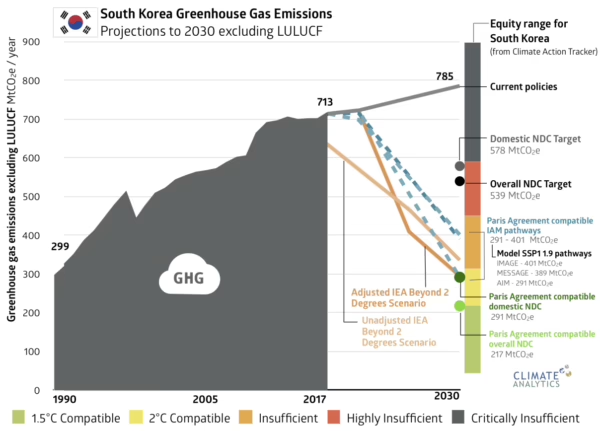Transitioning towards a zero-carbon society: science-based emissions reduction pathways for South Korea under the Paris Agreement
Authors
Ursula Fuentes Hutfilter, Ryan Wilson, Matthew Gidden, Gaurav Ganti, Deborah Ramalope, Bill Hare
Share

2020 is a critical year for more ambitious emissions reductions: Governments are expected to bring forward enhanced emission reduction commitments (Nationally Determined Contributions, or NDCs) with more ambitious 2030 targets, and new long-term low emissions sustainable development strategies (LT-LEDS) that bring collective action in line with the Paris Agreement’s Long Term Temperature Goal. This report, produced in collaboration with Korean institute Solutions for Our Climate outlines a 1.5°C compatible pathway to align South Korea’s climate targets with the Paris Agreement.
South Korea’s current NDC is rated as “highly insufficient” by the Climate Action Tracker, and if all governments’ climate targets were in the same range, the world would warm by 3 to 4°C, more than double the limit in the Paris Agreement. Like all other nations that signed the Paris Agreement, South Korea is obligated to update its NDC in 2020 in order to play its part in reducing global emissions sufficiently by 2030 to keep the 1.5°C limit in the Agreement within reach, and close the gap identified by the world’s peak climate science body, the Intergovernmental Panel on Climate Change (IPCC).
The intended Green New Deal legislation aiming for a net zero emissions target in 2050 is an opportunity to link it with an enhanced NDC target to ramp up climate ambition and action.
Here are the key considerations for South Korea in strengthening its NDC:
- Transformational ramping up of ambition – not just incremental change – is needed. Dynamic technological and social developments and innovation make this possible.
- The overall NDC, which incorporates both domestic reductions and its fair share contribution to the international effort, needs to be scaled up to 70-94% below 2017 emission levels by 2030. At present its NDC target is only 24.4% below 2017 levels.
- A fair share contribution to international efforts needs to complement an adequate domestic target and lead to real and additional emission reductions. It cannot replace this domestic contribution to deep decarbonisation in line with the Paris Agreement. The recent announcement to account for management of existing forest as a large part of this non-domestic contribution would reduce this additional contribution to international effort and risk reducing the overall level of ambition without real and additional reductions.
- In line with good practice, South Korea’s NDC needs to be expressed as reduction against a base year in absolute emission terms, rather than against a Business-as-Usual (BAU) projection. At present the NDC is described as a reduction of 37% below BAU. The new NDC target would need a reduction of at least 74% below BAU (corresponding to 70% below 2017 emission levels) to constitute a fair share to achieving the Paris Agreement Long-Term Temperature Goal.
- The domestic reduction component of the NDC would need to be scaled to up to 59% below 2017 emission levels by 2030. At present its domestic reduction target is only 19% below 2017 levels. Expressed as change from BAU, the domestic target would need to be increased from the current 32.5% to a 66% reduction below BAU (59% reduction below 2017 levels). This would be consistent with a global least-cost pathway in line with the Paris Agreement, which minimises reliance on large-scale carbon dioxide removal (CDR) technologies and mitigation options in the future.

A strategy to achieve this reduction would need to address transformational contributions by all sectors, building on the current approach of sectoral targets. In particular, it would need to accelerate the transition away from coal and other fossil fuels towards renewable energy. South Korea’s power mix has a low share of renewable energy but the country has significant potential for expanding solar photovoltaics and wind. It can then also build on its aim to develop a hydrogen economy, focusing it on green hydrogen.
Fast action to fully decarbonise the electricity generation is a fundamental step in reducing emissions in all other sectors, where electrification plays an important role. South Korea needs to phase out coal for power generation by 2029, which entails developing a clear roadmap. A fast and orderly phase-out of coal from power generation brings many additional economic, environmental, and health co-benefits which builds the foundations for a just and well-managed energy transition.













